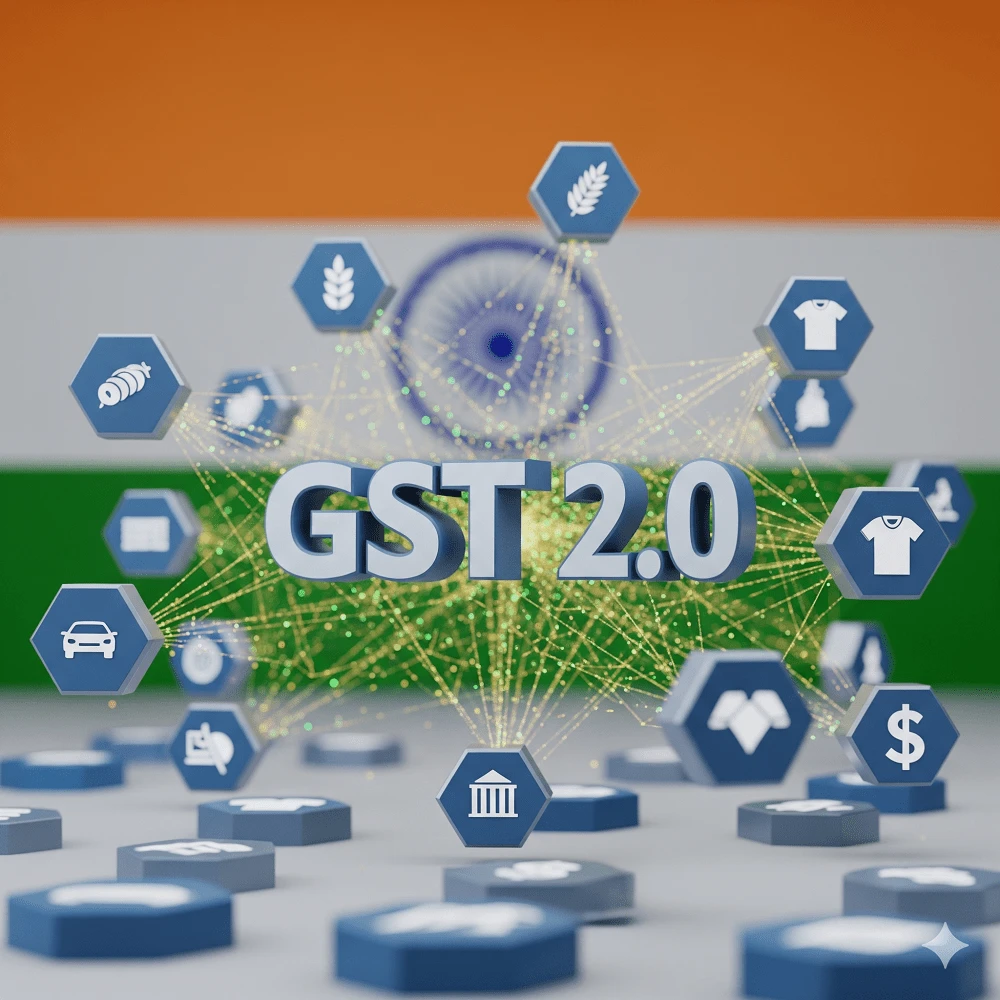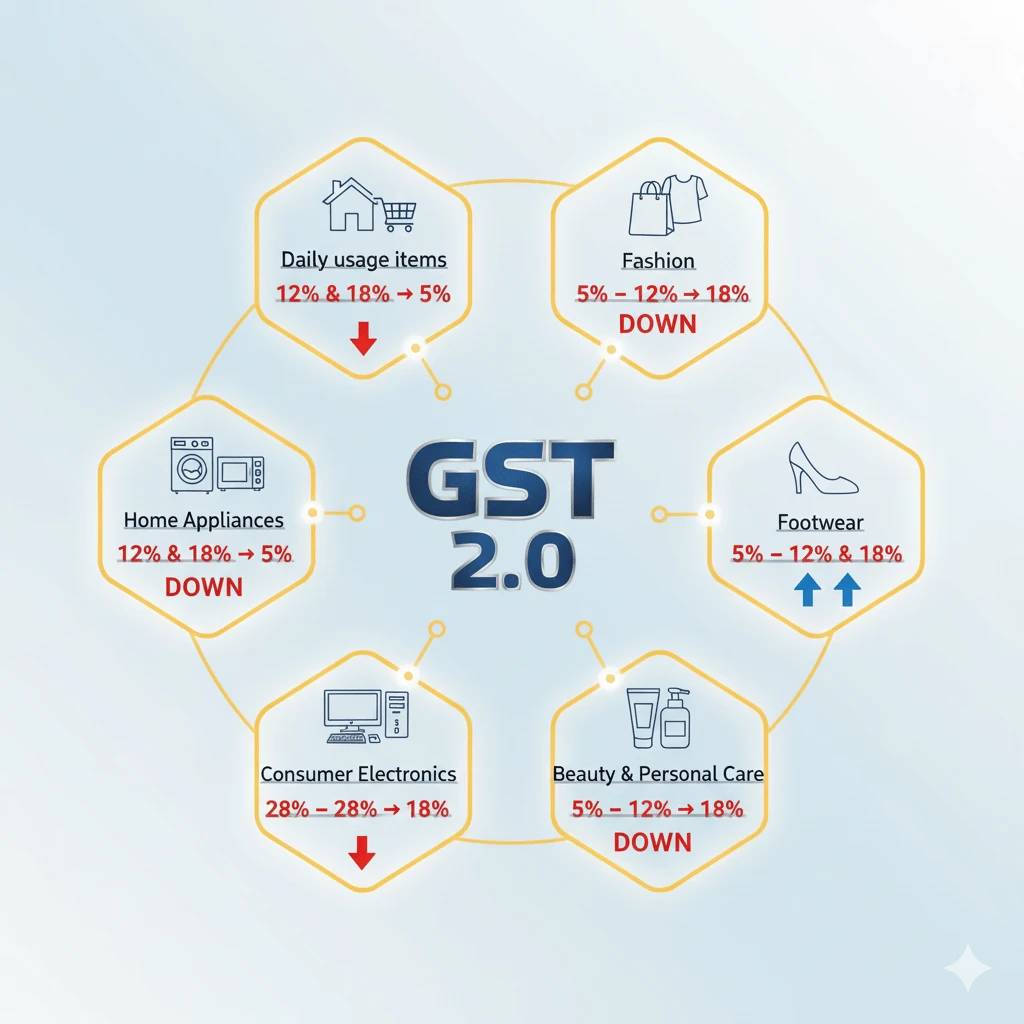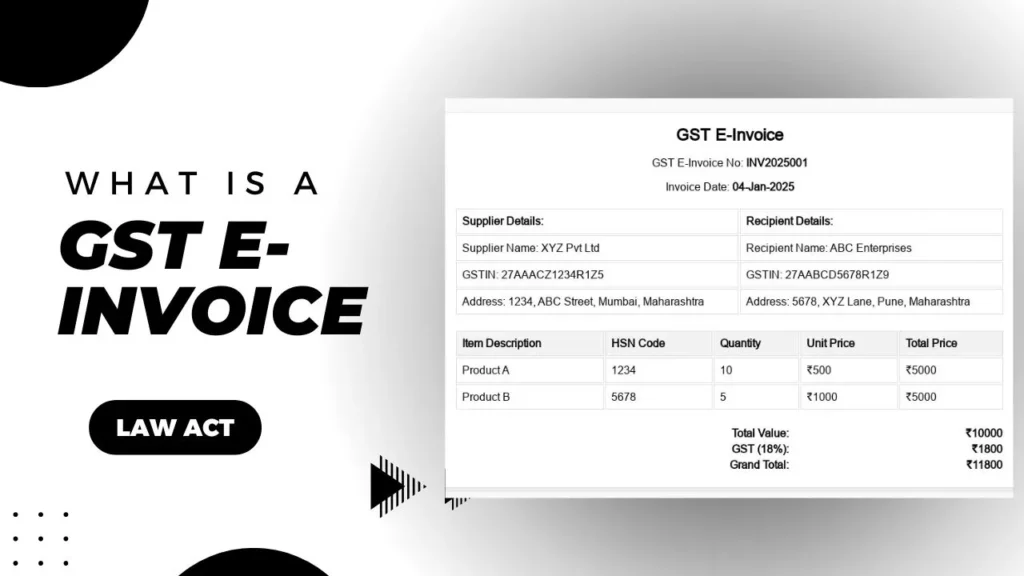The year 2025 has brought one of the biggest reforms in India’s tax system since GST (Goods and Services Tax) was first introduced in 2017. The government has simplified GST slabs, reduced rates on essential goods, increased taxes on luxury and harmful items, and introduced several measures to make compliance easier for businesses.
These changes are often called “GST 2.0”, and they came into effect on September 22, 2025, just before the festive season.
Key GST Changes in 2025 (GST 2.0)
Here are the main updates in GST rules for 2025:
1. New GST Slabs
The government has reduced the number of tax slabs from four to three.
- 5% GST → For daily-use and essential items like food products, soaps, basic medicines, and small household goods.
- 18% GST → For most standard goods and services such as electronics, furniture, packaged food, and clothing under ₹2,500.
- 40% GST → For luxury and harmful products like alcohol, tobacco, luxury cars, and high-end branded items.
This makes the system easier to understand and reduces confusion for both consumers and businesses.
2. Zero-Tax (Exempted) Category
Some goods and services have been made tax-free (0% GST). This includes:
- Life and health insurance
- Education services like private tuition
- Medicines for critical illnesses
- Charitable and social services
This move is aimed at reducing the financial burden on families and supporting health and education.

3. Two-Wheelers Become Cheaper
Earlier, motorcycles and scooters were taxed at 28% GST. In 2025, this has been reduced to 18%, making two-wheelers more affordable for the middle class.
For example:
- A scooter priced at ₹80,000 earlier attracted around ₹22,400 tax.
- Now, it attracts only ₹14,400 tax — saving buyers nearly ₹8,000.
This is expected to boost sales in the auto industry.
4. Hotels and Travel
- Hotel rooms costing below ₹7,500 per night now attract only 5% GST (earlier it was 12%).
- This will help the tourism and hospitality sector, especially during peak travel and festive seasons.
5. Handicrafts and Carpet Industry
GST on handmade carpets, handicrafts, and related goods has been reduced from 12% to 5%.
This helps local artisans in cities like Bhadohi and Srinagar, making Indian handicrafts more competitive in global markets.
6. Clothing and Apparel
Not all industries benefited. Clothing priced above ₹2,500 now comes under 18% GST, instead of 12%.
This could increase the prices of branded apparel and reduce sales in the middle-class segment.
7. Export Refunds Made Easier
For exporters, refunds of less than ₹1,000 will now be processed faster and automatically.
This helps small businesses improve their cash flow and reduces paperwork.
8. Simplified Business Compliance
Businesses had earlier faced challenges like matching credit notes with invoices. In GST 2.0, this requirement is removed.
This makes compliance easier for industries like FMCG (fast-moving consumer goods), where thousands of invoices are generated daily.

Who Benefits from GST 2.0?
✅ Consumers
- Essentials and daily-use items are now cheaper.
- Lower hotel tariffs, affordable two-wheelers, and reduced tax on healthcare and education services bring relief to families.
✅ Businesses
- FMCG companies save time with simplified compliance.
- Small exporters benefit from faster refunds.
- Hotels and handicraft industries expect a demand boost.
✅ Economy
- Reduced inflation as essential goods become cheaper.
- More disposable income in the hands of the common man.
- Encouragement to sectors like tourism, automobiles, and handicrafts.
Who Might Face Challenges?
❌ Apparel Industry
With GST on clothes above ₹2,500 increased to 18%, demand in mid-level fashion might reduce.
❌ Luxury Buyers
Luxury cars, expensive branded goods, alcohol, and tobacco now attract 40% GST. These products will become even more costly.
❌ Insurance Companies
Some insurance firms raised concerns about input tax credit (ITC). The government has promised to review this.
Impact on Different Sectors
| Sector | GST Change | Effect |
|---|---|---|
| Two-Wheelers | 28% → 18% | Affordable, more sales |
| Hotels | 12% → 5% | Cheaper stays, tourism boost |
| Carpets/Handicrafts | 12% → 5% | Better exports, higher local demand |
| Apparel (>₹2,500) | 12% → 18% | Higher cost, demand may drop |
| Luxury Goods | 28% → 40% | More expensive |
| Healthcare/Education | 0% | Families save money |
| Exporters | Faster refunds | Better cash flow |
Why This Reform Matters
- Simplification: From four slabs to three, easier to understand.
- Affordability: Middle-class and lower-income families save on essentials.
- Economic Growth: Expected to push consumption, especially during festivals.
- Support for “Make in India”: Handicrafts, local manufacturing, and small exporters benefit.
Conclusion
The latest GST rules in 2025 (GST 2.0) mark a turning point in India’s tax system. By cutting taxes on essentials, making compliance easier, and increasing rates only for luxury and harmful goods, the government is aiming to strike a balance between consumer relief and revenue generation.
For ordinary people, this means cheaper household items, affordable two-wheelers, and lower hotel bills. For businesses, it means simpler rules and faster refunds. Of course, some sectors like fashion and luxury will feel the pinch, but overall, GST 2.0 is expected to boost demand and support India’s growth story in 2025 and beyond.
Also Read:
- All Types of Full Form in GST
- About GST and Its Impact on the Indian Economy
- How to check GST number: Step-by-Step
- How Does GST Return Penalty Work
- GST on Rent in India: A Comprehensive Guide
Frequently Asked Questions
What are the new GST slabs introduced in 2025?
In 2025, the government reduced GST slabs to three main categories: 5%, 18%, and 40%. Essentials like food, soaps, and medicines come under 5%. Most standard items are at 18%. Luxury and harmful products such as tobacco, alcohol, and luxury cars now attract 40% GST.
Which items are now tax-free under GST 2025?
Some important services and products have been moved to the zero-tax or 0% GST category. This includes life and health insurance, education services like private tuition, charitable activities, and certain medicines. The goal is to reduce financial stress for common families and make healthcare and education affordable.
How do the new GST rules affect two-wheelers?
The GST rate on scooters and motorcycles has been cut from 28% to 18%. This means lower prices for buyers. For example, a scooter priced at ₹80,000 now has around ₹8,000 less tax. This change supports the automobile sector and encourages more people to buy two-wheelers.
How has GST changed for hotels and tourism?
Hotel rooms priced below ₹7,500 per night now attract only 5% GST instead of 12%. This makes stays cheaper for tourists and families. The change helps boost tourism, especially during festivals and holiday seasons, and provides relief to the hospitality sector which struggled after the pandemic.
What changes happened in clothing and apparel GST?
Clothing items priced above ₹2,500 are now taxed at 18% GST, instead of the earlier 12%. This may make branded clothes and premium apparel more expensive. While budget clothes remain affordable, middle-class shoppers may feel the pinch. The fashion industry has expressed concerns about demand possibly slowing down.
How does GST 2025 affect exports and small traders?
In GST 2.0, exporters with refund claims below ₹1,000 will receive faster refunds. This benefits small traders and exporters by improving cash flow and reducing paperwork. It saves time, avoids delays, and supports India’s export sector, especially small businesses that rely on quick payments for working capital.
Which industries gain the most from GST 2025?
Industries like FMCG, handicrafts, two-wheelers, and hotels benefit the most. Essentials are cheaper, compliance is easier, and local artisans get a boost due to lower taxes. The hospitality sector also gains from reduced hotel tax rates, which are expected to attract more travelers and improve business profits.
What is the impact of GST 2025 on luxury goods?
Luxury and sin goods such as alcohol, tobacco, expensive cars, and premium branded items now face 40% GST. This makes them more costly than before. The aim is to discourage harmful consumption and increase government revenue. However, it may reduce demand in the high-end luxury segment.
Why is GST 2025 called GST 2.0 in India?
The 2025 reforms are called GST 2.0 because they represent a major upgrade from the old system. Instead of four slabs, there are now three. Many items are tax-free, and compliance is simpler. It makes GST easier for consumers, businesses, and the government, marking a fresh beginning.



